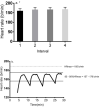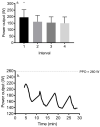Characterizing the Heart Rate Response to the 4 × 4 Interval Exercise Protocol
- PMID: 32679757
- PMCID: PMC7399937
- DOI: 10.3390/ijerph17145103
Characterizing the Heart Rate Response to the 4 × 4 Interval Exercise Protocol
Abstract
High intensity interval training is frequently implemented using the 4 × 4 protocol where four 4-min bouts are performed at heart rate (HR) between 85 and 95% HR max. This study identified the HR and power output response to the 4 × 4 protocol in 39 active men and women (age and VO2 max = 26.0 ± 6.1 years and 37.0 ± 5.4 mL/kg/min). Initially, participants completed incremental cycling to assess VO2 max, HR max, and peak power output (PPO). They subsequently completed the 4 × 4 protocol, during which HR and power output were monitored. Data showed that 12.9 ± 0.4 min of 16 min were spent between 85 and 95% HR max, with time spent significantly lower in interval 1 (2.7 ± 0.6 min) versus intervals 2-4 (3.4 ± 0.4 min, 3.4 ± 0.3 min, and 3.5 ± 0.3 min, d = 2.4-2.7). Power output was highest in interval 1 (75% PPO) and significantly declined in intervals 2-4 (63 to 54% PPO, d = 0.7-1.0). To enhance time spent between 85 and 95% HR max for persons with higher fitness, we recommend immediate allocation of supramaximal intensities in interval one.
Keywords: exercise prescription; heart rate; high intensity interval training; intermittent exercise.
Conflict of interest statement
The authors declare no conflict of interest.
Figures


References
-
- Nybo L., Sundstrup E., Jakobsen M.D., Mohr M., Hornstrup T., Simonsen L., Bülow J., Randers M.B., Nielsen J.J., Aagaard P., et al. High-intensity training versus traditional exercise interventions for promoting health. Med. Sci. Sports Exerc. 2010;42:1951–1958. doi: 10.1249/MSS.0b013e3181d99203. - DOI - PubMed
MeSH terms
LinkOut - more resources
Full Text Sources

